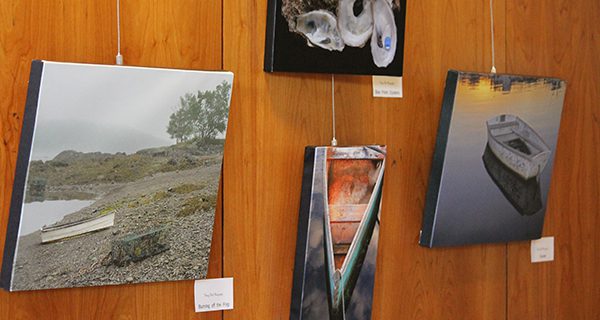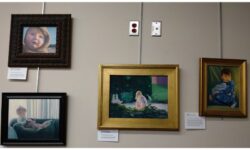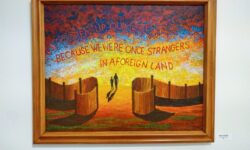[ccfic caption-text format="plaintext"]
By James Kinneen
Hometown Weekly Reporter
For the entire month of March, the Wellesley Library displayed a three-collection exhibit of Nancy Rich’s work based around the concept of “Afloat.” Rich, a member of the Wellesley’s Clever Hand Gallery cooperative and a former administrator at Dana Hall School, is the photographer of a 2009 book of photographs celebrating the wooden rowboats of the New England and Canadian shores.
In her “Afloat” exhibit, Rich returns to those ever-diminishing dinghies and rowboats that have become even rarer since the 2009 book with “Nor’eastern Dinghies,” a collection of images showing the small wooden rowboats that were once ubiquitous in the region. But it’s not just the fact that worn wooden rowboats are aesthetically pleasing that draws Rich to photograph them. She is seeking to ensure their history is maintained in photo.
“Wooden rowboats may be rudimentary in design or works of exceptional craftsmanship,” Rich explained. “A driving force for me was to create a historical record of wooden rowboats. The book, along with exhibits such as this, help preserve the memory of the now elusive wooden boats of New England and the Canadian maritimes.”
One of the results of chronicling these boats is that New Englanders who grew up when the boats were more common are reminded of the past - and the boats they likely gave little thought to years ago.
“While these boats are iconic to the coastline of New England, they have sadly all but been replaced by boats made of fiberglass, rubber, aluminum, and plastic,” Rich said. “Many New Englanders, particularly those who grew up along the coast, are nostalgic for these boats. My ‘Afloat’ exhibit helps remind all of us of the once ubiquitous presence and beauty of wooden rowboats.”

Rich’s display highlights wooden boats, as well as the various sculptures made by nature that appear on beaches.
The second third of her exhibit is titled, “Sea Sculptures of the North Atlantic,” and is devoted to “nature’s artwork,” the natural sculptures that wash up on beaches, having been crafted by the formidable elements of nature.
Rich believes that “each ‘sculpture’ has a beauty to it that makes it worthy of a work of art,” while noting that this aesthetic beauty comes from a place of survival, as “the sea life that makes its habitat along the coast is tenacious in its will to live. It finds ways to survive the powerful churning waves, pulling it against rocks and the abrasive sandy floor. These formidable elements of nature carve and polish the unique shapes of each sea sculpture.”
While her first two collections evoke nostalgia for a bygone New England past, and a respect for nature’s violent beauty, her third collection, “Glass, Liquids and Ice Capades,” is supposed to be more lighthearted and fun.
“A third collection includes images that are more whimsical, and I hope that they bring a sense of joy to the visitor,” commented Rich. “They capture the interplay of colorful objects floating in a liquid, and the delightful bubbles that move in all directions around those objects.”
When viewing this, as well as her other work, it is abundantly clear that Rich has a strong connection to both the ocean and to water in general. As she put it: “I cannot remember a time when I wasn't drawn to the sea. I fixate on, and am awestruck by, the movements of the ocean, its colors, its power, and its vastness. Water captivates me as it takes on colors that vary with the time of day, the weather, and the objects around and in it. The ocean routinely changes in color to appear blue, gold, black purple, green, or silver, sometimes all within a short period of time.”
But if you think you have to be a lover of the ocean to enjoy Rich’s work, you would be incorrect.
In the guestbook in front of Rich’s display at the library, a woman named Charlotte praised a few of the photos before adding in part: “Starr’s boat is a beautiful piece of art. I’m not really a swimmer, boater or beachgoer but I feel that that piece speaks to me. Great work!”






















